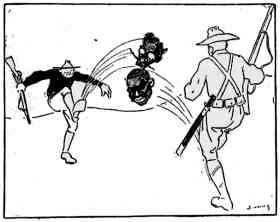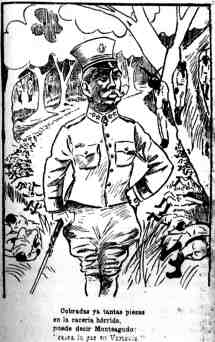
Race War of 1912 - A Timeline
April 23. Gerardo Machado resigns from the cabinet of President José Miguel Gómez, in opposition to a "policy of partiality and proscription, prompted by purposes of hate and exclusion."
May 17. Evaristo Estenoz and Pedro Ivonnet (co-founders of the Partido Indepediente de Color, hold a meeting in Santiago. Estenoz calls for a massive, island-wide demonstration on May 20, the anniversary of the republic.
May 20. The planned demonstrations by members of the Partido Independiente de Color take place in Oriente and Santa Clara. The other provinces (Havana, Pinar del Rio, Matanzas and Camagüey) do not participate. Conservative estimates the following day report 300 to 600 participants in Oriente (most unarmed) and about 60 in Santa Clara.
Estenoz writes to the administrator of the U.S.-owned sugar mill Soledad requesting 25 guns and ammunition. He warns that he will destroy the estate's fields and mill.
May 21. Military troops are sent to Oriente.
May 24. The U.S. government authorizes marines to be dispatched from Guantánamo Naval Station to protect American lives and property. Three warships leave for Cuba: Prairie, Nashville, and Paducah.
May 25. Repression of the demonstration in Oriente has already started (even though there has been no property or physical damage), and newspapers have interpreted the events as a race war. "In short," wrote Aline Helg in Our Rightful Share, "repression preceded Independiente action… partly based on the belief that people of African descent were fanatic, violent, and irresponsible."

May 25. A note delivered to the Cuban Secretary of State by the American minister warns of another military intervention if "American lives and property" can't be protected.
May 26. At the House of Representatives, Campos Marquetti proposes amnesty for rebels who surrender within ten days.
May 27. General Monteagudo leaves from Havana for Oriente on the cruiser Cuba to take command of military forces.
May 27. An editorial in the conservative newspaper El Día, suggests that Cubans should follow a U.S. model of race relations, in which "blacks are mistreated and society is segregated." The author concludes, "dominated races do submit."
May 27. Congress passes a unanimous resolution that supports the government's policy in Oriente. (Marquetti's proposal of amnesty is ignored.)
May 31. In Oriente, General Carlos Mendieta invites journalists to witness "the efficiency of the army's new machine guns." He fires on an alleged rebel camp, and 150 peaceful Afro-Cuban peasants are killed or wounded. "Entire families were machine-gunned in their bohíos," wrote Aline Helg in Our Rightful Share. " According to one witness, the cries of the wounded resonated in the distance, and for days vultures circled over the area, attracted by the corpses."
May 31. In Oriente, independents attempt to show their determination with "limited sabotage." They burn a bridge, a post office, and the barracks of a rural guard, some wooden houses (which belong to the Santa Cecilia Sugar Company) and a railway station. This is the first act of violence instigated by the independents.
June 1. A manifesto issued by Juan Gualberto Gómez condemns the independents and shares the views of mainstream Afro-Cuban politicians, which includes concerns with the recent upsurge of white racism.
June 1. Independents take control of the town La Maya,
where Afro-Cubans are the majority. Some buildings and houses burn.
June 2. In Oriente, Afro-Cuban leader Isidro Santos Carrera burns down the sugar mill La Maya.
June 3. President Gómez asks Congress for the right to declare martial law. The request is granted on June 5.
June 6. President Gómez asks the Cuban people to fight for "civilization" against the "ferocious savagery" of the independents. He invokes the image of a "raped teacher," which turns out to be a story fabricated by a conservative newspaper and not based on fact.
June 7. Congress approves 1 million pesos to put down the independents, and authorizes the president to enlist and organize men as necessary.
June 9. Beaupré requests the U.S. State Department to send a warship to Havana for "moral effect."
June 10. U.S. warships Washington and Rhode Island anchor in Havana. They stay until July 1. Their presence magnifies the negative rumors being spread.
June 12. Captain Arsenio Ortiz captures independent leader Gregorio Surín. 45 rebels are killed.
June 15. Genera Menocal, from his Chaparra sugar mill in Oriente, offers to supply the Army with 1,000 cavalrymen.
June 17. The French ambassador to Cuba sends home a report which reads in part: "The truth, I think, is as follows: There was an agreement between the President and the independents in view of a reelection; the president would appear as a savior, one would fight little, one would be content with threatening, and it would be mostly 'the cavalry of St. George' that would come into play."
June 20. Various newspapers accuse French consul Henri Bryois (who has opposed the massacre since the beginning) of conspiring with the independents. Members of the government express desire to expel him from the island, and the French Government eventually recall him.

June 22. By this date, over 700 rebels have surrendered, and it is estimated that about 500 returned home quietly.
June 25. General Monteagudo confronts rebels at Mícara. The government forces create such carnage that they can't tell how many rebels they killed.
June 27. Estenoz is killed ("shot point blank"), along with 50 other men near Alto Songo. His body is displayed "covered with flies" in Santiago de Cuba.
July 15. Constitutional guarantees are restored in Oriente.
July 18. Ivonnet surrenders to authorities near El Caney. He is killed while "trying to escape." His body is publicly displayed. [Both Ivonnet and Estenoz were buried in common graves to prevent them from becoming symbols that could revive their memories.]
August 7. 500 Afro-Cuban prisoners are transferred to Havana.
Race in Cuba
Opening | Introduction | End of
Slavery | Race Fear |
After the War |
SUGAR |
Race War | Race War
Timeline | José
Miguel Gómez | Morúa
Delgado | Fernando Ortíz |
Julián Valdés Sierra |
Oriente Province |
Martí on Race |
Bibliography
Return to 1912